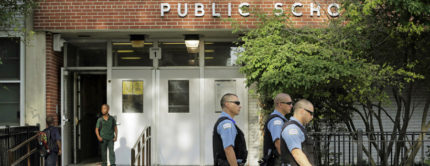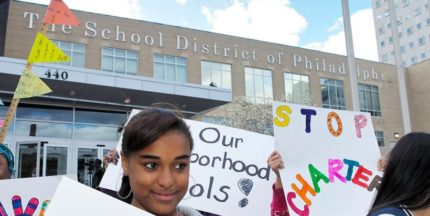When it comes to education, it is well known that class size matters. The student-to-teacher ratio significantly impacts the quality of the academic process, as a wide body of research paints the reduction of class size as an established way of improving an array of educational outcomes. Elite private schools know this well, as their students commonly benefit from student-to-teacher ratios below the public school average of 16-to-1.
Such studies further reveal class reduction to be particularly beneficial for African-American and low-income children — those often saddled with higher student-to-teacher ratios — and that increases in class size will likely harm these populations. So given this well-established research, why is it a common practice in urban centers like Baltimore to shut down public schools once they fall beneath a certain level of enrollment?
“With smaller populations, those classrooms become smaller, and parents and advocates against these closures say ‘well, small classrooms are what the literature says is good for children,” said Dr. Lawrence Brown, associate professor at the Morgan State School of Community Health and Policy in Baltimore. “But it becomes a penalty in these closure discussions.”
Such was the case with the Baltimore city school board’s December 19 decision to close five schools at the end of the school year, largely due to low enrollment and associated costs. The decision came a month after the board’s annual review of citywide enrollments and student performance, and on the heels of a $1 billion initiative to replace aging Baltimore schools and construct 28 new ones. At the same meeting, the board postponed an official decision on William Pinderhughes Elementary/Middle School in the Sandtown-Winchester community of West Baltimore, the impoverished neighborhood of the late Freddie Gray. Although its 250-student enrollment was also well below the common closure threshold of 400, the Pinderhughes school was spared as a result of a sustained rallying effort by the school’s leaders, teachers, parents, students and community activists.
“Because of the advocacy of the students in particular, but also of the community and the stakeholders of this school, the CEO announced she was reversing her recommendation for the school to close,” said Rev. Cortly “CD” Witherspoon, community organizer and a parent at Pinderhughes. Known as a “community school” with strong leadership, Pinderhughes runs after-school programming, a food pantry, a clothing drive, social services and community workshops for parents on financial literacy and other relevant subjects. In Baltimore, said Witherspoon, “we have schools in some neighborhoods that are literally right around the corner from each other because we went from a city of being a million people in the ’90s to now being 630,000.” Given the enrollment dilemma was unavoidable, Witherspoon stressed: “we tried to make the best out of a situation we knew we’d eventually have to encounter while figuring out how to make it work for the community.”
“It was the powerful testimony of young people that most influenced my thinking,” acknowledged Baltimore City Schools CEO Sonja Santelises, at the meeting. Santelises, who manages Maryland’s fourth-largest school system with 80,592 students and over 80 percent African-American, further stated the district would work with Pinderhughes and nearby Gilmor Elementary on a plan to create a “single, sustainable, high-quality program for the Sandtown community.” Given both schools currently have very low enrollments in the mid-200 range, the merged reinvention of Pinderhughes will maintain its small class sizes while continuing to operate as a community school with enhanced services. “As parents, smaller class sizes are an ideal we want to make happen for our kids,” said Witherspoon, who was among the community representatives that met with Santelises to conceptualize an enhanced Pinderhughes.
The popularity of this ideal is apparent as national parent groups like the nonprofit Parents Across America (PAA) pull from existing research to tout such benefits as increased student achievement, better grades, higher test scores, smaller achievement gaps, improved attendance, less teacher turnover and better working conditions. Consistently, the PAA highlights and recommends past successful approaches like the California class size reduction program where average class size was reduced by roughly one-third in traditional public elementary schools. In five of the state’s largest school districts other than Los Angeles, researchers found that “overall, smaller classes have a greater positive effect on students in low-income schools” and that “in Fresno, Long Beach, Oakland, San Diego and San Francisco, test scores increased 14 percent in math and 9 percent in reading in schools with mostly low-income students.”
Still, for urban communities, there is a larger issue. “Nationally, these school closures, especially in disinvested and redlined Black communities, are happening in a specific context,” offered Brown, noting the proliferation of rising rents, foreclosures and displacement since the 2008 economic crisis and its ongoing impact on African-American communities. “What’s happening is that Black neighborhoods are losing populations in these big urban areas,” he explained, stressing cities like Atlanta, Detroit, New York, Chicago and Baltimore are “pushing Black people out because they can’t afford the mortgage or the rent.” Therefore, continued Brown, “you see a decline in the population feeding many of these public schools. I look at it as a punitive policy arrangement that penalizes Black communities for being victimized by the housing crisis that occurred a decade ago.”
Given these troubling dynamics, Witherspoon wanted to get out in front of the closure issue as it related to Pinderhughes. “We requested 12 to 16 months where we could bring the Pinderhughes and Gilmor communities together to fellowship and work with parents, students, stakeholders and North Avenue (school board) in a workgroup type of setting so our voices are heard collaboratively with the decision makers, and so they are not making key decisions affecting our community for us,” explained Witherspoon, reporting Santelises indicated her initial approval for this process. He emphasized that, in most cases, recommendations for closures are announced and the pushback doesn’t affect the ultimate decision but, in this case, the students made all the difference. “They showed up every hearing that we had at the Board of Education and they articulated why their school was important to them,” said Witherspoon. “So this was not something where the school board was telling us what they were going to do with our community, we presented a plan and the CEO was open and receptive to that plan.” Witherspoon believes such a proactive and collaborative approach, one moving beyond mere protest to recognize communal need, local budget constraints, and the importance of a forward-thinking community-based plan, represents “a new model” for tackling such urban dilemmas.
By all accounts, Santelises was in a tough position, given state data and local policy highlight the significant costs of maintaining low-enrollment schools. Maryland uses school personnel salary cost data and breaks it down in a per student analysis to gauge the operational efficiency of its traditional public schools. Relatively larger schools with student enrollments of 600 or more, the data reported, are “more economically efficient to operate than similar smaller schools” with student enrollments below 400. For example, a traditional high school in Maryland with an enrollment less than 400, on average, costs $8500 per student each year, while one with an enrollment over 800 costs $6100 per student, or $2400 less. However, concluded the study, “these data do not show whether larger schools are more cost-effective — that is, whether the larger schools are not only more economically efficient but also more effective at producing higher levels of student achievement.”
Consistently, evidence has long existed that depicts this traditional cost-cutting approach as being financially counterproductive over time. “What you find is that the increase in earnings is twice as high as the costs, so the benefits are twice as high as the costs,” revealed Princeton’s Alan Krueger in a 2000 interview. His study projected that a 10 percent increase in spending per student, the equivalent of reducing a class of 22 students to 15, would lead to a 1 percent increase in a student’s lifetime earnings. More recent studies have also shown that class size reduction produces a variety of benefits that can potentially outweigh many short-term costs.
“Even if the research didn’t say that, I still think there are other considerations that aren’t being put on the table,” said Brown, noting that “many Black public schools are resources to their neighborhoods. They may be food pantries, operate after-school programs, act as community hubs and as centers for democracy with polling sites where people go and vote.” Administrators in urban areas, continued Brown, “look at these schools as mere cost-saving units. But even if there is a way to decrease costs, cost should not be the sole metric by which we look at Black public schools, especially those in disinvested, redlined Black communities.”

